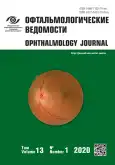Estimation of lacrimal dysfunction indices in patients with recurrent pterygium
- Authors: Bilalov E.N.1, Yusupov A.F.2, Nozimov A.E.2, Oripov O.I.1
-
Affiliations:
- Tashkent Medical Academy
- Republican Specialized Scientific and Practical Medical Center of Eye Microsurgery
- Issue: Vol 13, No 1 (2020)
- Pages: 11-16
- Section: Original study articles
- URL: https://journals.rcsi.science/ov/article/view/19242
- DOI: https://doi.org/10.17816/OV19242
- ID: 19242
Cite item
Abstract
The rationale of the research is driven by the severity of dry eye syndrome (DES) in the pterygium recurrencies development as well as by the necessity to investigate tear dysfunction and methods for its optimal correction in this patient population.
Purpose of the study. To assess the impact of tear dysfunction indices on the development of recurrent pterygium.
Materials and methods. We observed 60 patients (67 eyes) with recurrent pterygium. Patients were divided into four observation groups depending on the number of recurrencies. In order to study the dynamics of the DES manifestations during the postoperative period, pathogenetic therapy was used, which included a tear fluid substitute. All patients underwent a comprehensive assessment of subjective and objective DES indices before and after surgery.
Results. A positive dynamics of subjective manifestations and objective indices of DES under the action of a tear substitute after surgery was reliably confirmed. A decrease in the number of patients with type III and IV crystallization after surgery was confirmed. Conclusion. The obtained data indicate an increase in the mucin content in the tear fluid composition, which leads to a stabilization of the tear film and to a decrease in the DES intensity.
Full Text
##article.viewOnOriginalSite##About the authors
Erkin N. Bilalov
Tashkent Medical Academy
Author for correspondence.
Email: dr.ben58@mail.ru
ORCID iD: 0000-0002-3484-1225
Medical Sciences Doctor, Professor, Head of Ophthalmology Department
Uzbekistan, TashkentAzamat F. Yusupov
Republican Specialized Scientific and Practical Medical Center of Eye Microsurgery
Email: eye.center@mail.ru
Medical Sciences Doctor, Director. Chief Specialist in Ophthalmology of Ministry of Health of the Republic of Uzbekistan
Uzbekistan, TashkentAhmadjon E. Nozimov
Republican Specialized Scientific and Practical Medical Center of Eye Microsurgery
Email: dr.nae@mail.ru
Researcher
Uzbekistan, TashkentOkilkhon I. Oripov
Tashkent Medical Academy
Email: okil.oripov@mail.ru
Assistant
Uzbekistan, TashkentReferences
- Петраевский А.В., Тришкин К.С. Птеригиум. Этиопатогенез, клиника, лечение. – Волгоград: Панорама, 2018. – 96 с. [Petrayevskiy AV, Trishkin KS. Pterigium. Etiopatogenez, klinika, lecheniye. Volgograd: Panorama; 2018. 96 p. (In Russ.)]
- Маложен С.А., Труфанов С.В., Крахмалева Д.А. Птеригиум: этиология, патогенез, лечение // Вестник офтальмологии. – 2017. – Т. 133. – № 5. – С. 76–83. [Malozhen SA, Trufanov SV, Krahmaleva DA. Pterygium: etiology, pathogenesis, treatment. Vestnik oftal’mologii. 2017;133(5):76-83. (In Russ.)]. https://doi.org/10.17116/oftalma2017133576-83.
- Петраевский А.В., Тришкин К.С. Патогенетическая связь птеригиума и синдрома сухого глаза (клинико-цитологическое исследование) // Вестник офтальмологии. – 2014. – Т. 130. – № 1. – С. 52–56. [Petraevskii AV, Trishkin KS. Pathogenetic relationship between pterygium and dry eye syndrome (clinical and cytological study). Vestnik oftal’mologii. 2014;130(1):52–56. (In Russ.)]
- Ishioka M, Shimmura S, Yagi Y, Tsubota K. Pterygium and dry eye. Ophthalmologica. 2001;215(3):209-211. https://doi.org/10.1159/000050860.
- Макашова Н.В., Васильева А.Е., Колосова О.Ю. Влияние слёзозаменителей на состояние поверхности глаза при длительном использовании гипотензивных средств с консервантами // Вестник офтальмологии. – 2018. – Т. 134. – № 2. – С. 59–65. [Makashova NV, Vasil’eva AE, Kolosova OYu. Effects of artificial tears on ocular surface in glaucomatous patients with long-term instillation of preserved antiglaucoma eye drops. Vestnik oftal’mologii. 2018;134(2):59-65. (In Russ.)]. https://doi.org/10.17116/oftalma2018134259-65.
- Нозимов А.Э. Эффективность комбинированного хирургического способа лечения упорно рецидивирующего птеригиума // Вестник Башкирского государственного медицинского университета. – 2016. – № 2. – С. 118–121. [Nozimov AE. The effectiveness of the combined surgical method for the treatment of persistently recurring pterygium. Vestnik Bashkirskogo gosudarstvennogo medicinskogo universiteta. 2016;(2):118-121. (In Russ.)]
- Lin H, Yiu SC. Dry eye disease: a review of diagnostic approaches and treatments. Saudi J Ophthalmol.. 2014;28(3):173-181. https://doi.org/10.1016/j.sjopt.2014.06.002.
- Сафонова Т.Н., Гладкова О.В., Боев В.И. Значение метода лазерной конфокальной томографии в диагностике и мониторинге сухого кератоконъюнктивита // Вестник офтальмологии. – 2016. – Т. 132. – № 2. – С. 47–54. [Safonova TN, Gladkova OV, Boev VI. Significance of laser confocal tomography in diagnosis and monitoring of keratoconjunctivitis sicca. Vestnik oftal’mologii. 2016;132(2):47-54. (In Russ.)]. https://doi.org/10.17116/oftalma2016132247-54.
- Завгородняя Н.Г., Брижань А.А. Цитологический статус конъюнктивы и изменения качественного состава слезы у пациентов с синдромом «сухого глаза» после инстилляций современных топических фторхинолонов // Запорожский медицинский журнал. – 2014. – № 3. – С. 52–59. [Zavgorodnjaja NG, Brizhan’ AA. Cytologic status changes of the conjunctiva and tears qualitative composition in patients with “dry eye” syndrome after instillation of modern topical fluoroquinolones. Zaporozhskii meditsinskii zhurnal. 2014;(3):52-59. (In Russ.)]
- Rolando M. Tear mucus ferning test in normal and keratoconjunctivitis sicca eyes. Chibret Int J Ophthalmol. 1984;2(4):32-41.
Supplementary files











